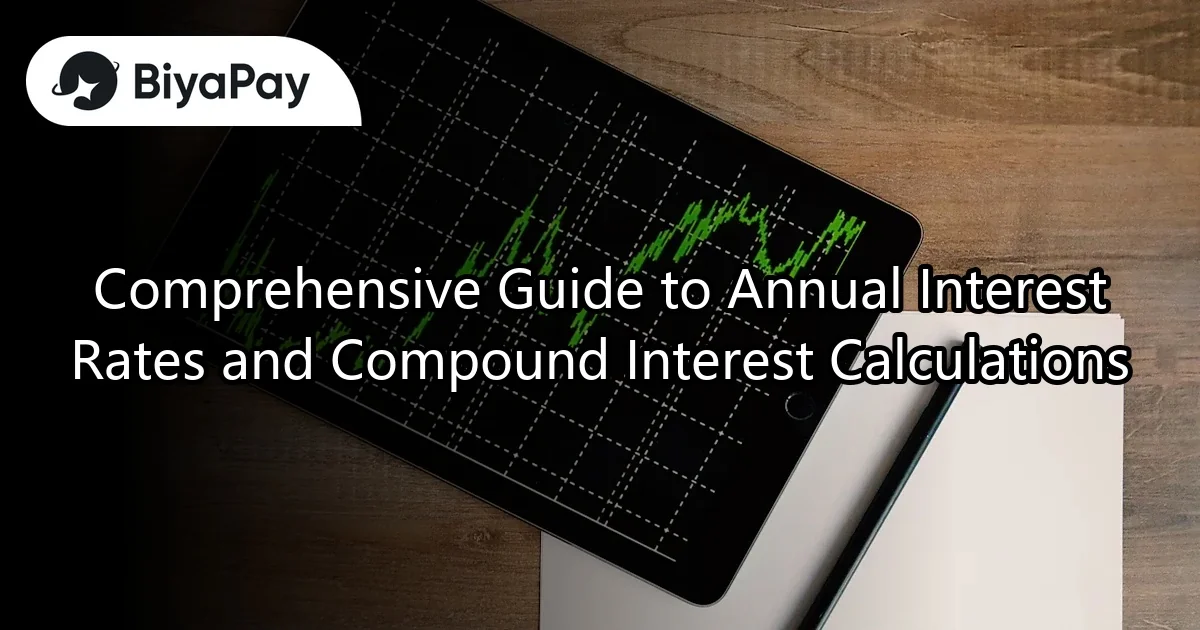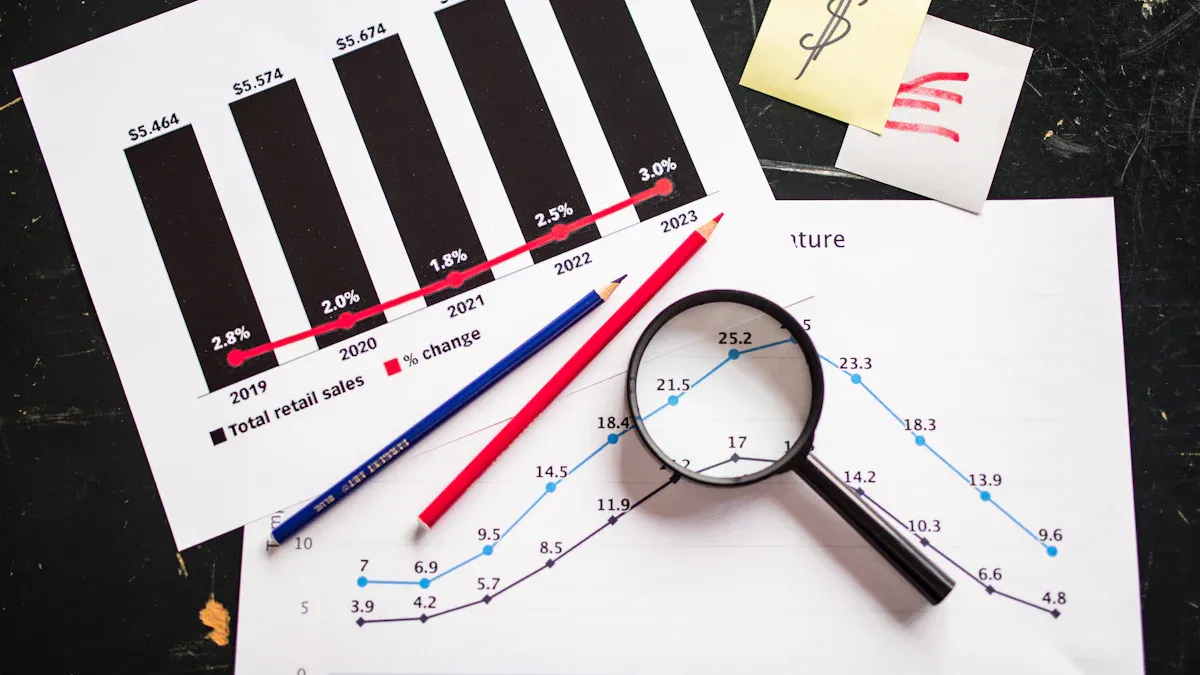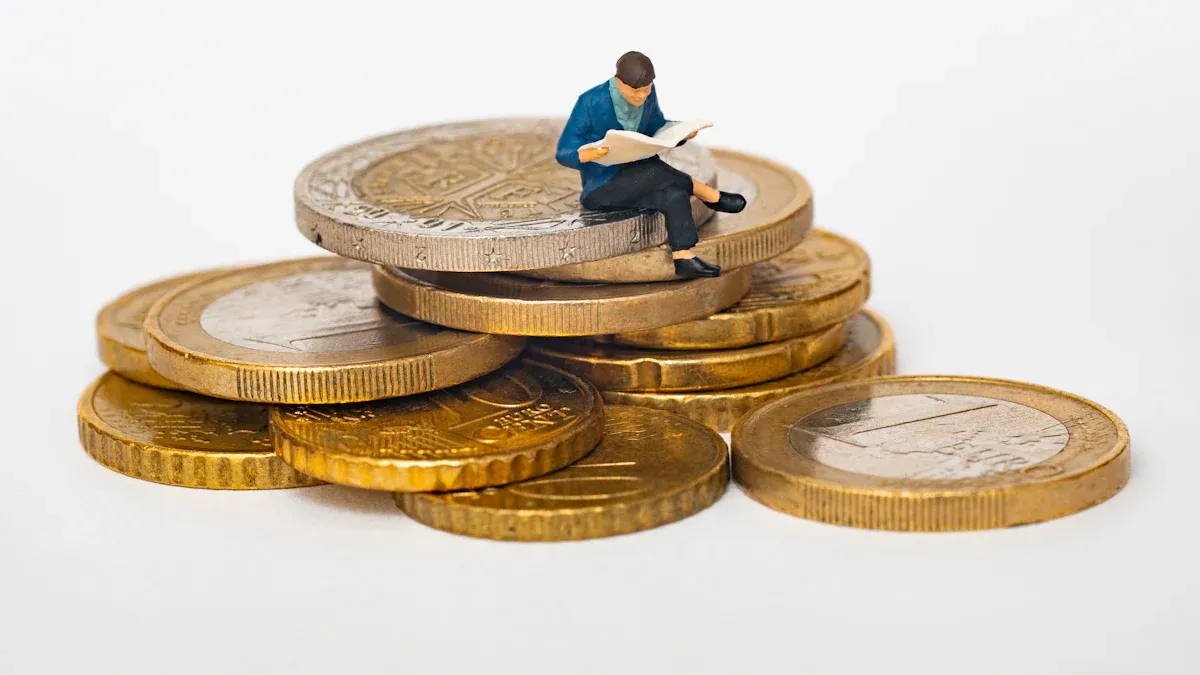- EasyCard
- Trade
- Help
- Announcement
- Academy
- SWIFT Code
- Iban Number
- Referral
- Customer Service
- Blog
- Creator
Comprehensive Guide to Annual Interest Rates and Compound Interest Calculations

Image Source: pexels
In financial management, annual interest rates and compound interest are two critical concepts. The annual interest rate represents the yearly growth proportion of funds, allowing you to clearly understand the cost of investments or loans. Compound interest, on the other hand, reinvests interest back into the principal, enabling assets to grow rapidly over time. You may not realize that through the power of compound interest, long-term investments can yield astonishing results. For example, investing 10,000 yuan annually with a 10% annualized return could grow to 25 million after 30 years. This demonstrates the importance of compound interest in retirement planning and future financial security. Mastering this knowledge can help you manage financial resources more effectively.
Definition and Calculation of Annual Interest Rates
Basic Concept of Annual Interest Rates
The annual interest rate is a key indicator for measuring the growth or cost of funds. It represents the proportion of funds’ growth within one year, typically expressed as a percentage. Whether for investments or loans, the annual interest rate helps you quickly understand the return or cost of funds. For instance, if you deposit 1,000 USD in a bank with a 5% annual interest rate, your principal will grow to 1,050 USD after one year.
The application of annual interest rates is extensive, covering fixed deposits, loan rates, credit card interest, and more. Understanding the basic concept of annual interest rates enables you to better evaluate the pros and cons of different financial products, leading to wiser financial decisions.
Tip: The annual interest rate only reflects interest calculations for a single year; for multi-year growth, the impact of compound interest must be considered.
Annual Interest Rate Calculation Formula
Calculating the annual interest rate is straightforward. The common formula is:
Annual Interest Rate (%) = (Interest ÷ Principal) × 100
For example, suppose you lend 1,000 USD and receive 50 USD in interest after one year. Using the formula:
Annual Interest Rate (%) = (50 ÷ 1,000) × 100 = 5%
This formula applies to simple interest calculations. For compound interest, the reinvestment effect of interest must be considered, making the calculation more complex. Many financial institutions and investment tools provide detailed annual interest rate data to help you quickly understand a product’s returns or costs.
Conversion Between Annual, Monthly, and Daily Interest Rates
In practical applications, annual interest rates often need to be converted to monthly or daily rates, especially for short-term loans or investments. Here are the common conversion methods:
- Monthly Interest Rate:
Monthly Interest Rate (%) = Annual Interest Rate (%) ÷ 12
For example, if the annual interest rate is 6%, the monthly rate is 0.5%.
- Daily Interest Rate:
Daily Interest Rate (%) = Annual Interest Rate (%) ÷ 365
If the annual interest rate is 6%, the daily rate is approximately 0.0164%.
These conversion formulas help you calculate short-term interest more accurately. For instance, credit card daily interest rates are typically based on annual rates, and understanding these formulas allows you to better grasp actual interest costs.
Further Reading: A book focused on the fixed-income market provides a detailed explanation of how annual interest rates are applied in various financial products, including bond interest calculations and yield curve computations. This knowledge can deepen your understanding of the practical use of annual interest rates.
Definition and Calculation of Compound Interest

Image Source: pexels
Difference Between Compound and Simple Interest
The main difference between compound and simple interest lies in how interest is handled. Simple interest is calculated only on the principal, while compound interest adds each period’s interest to the principal, calculating the next period’s interest on the new total. This means compound interest allows your funds to grow exponentially over time.
For example, suppose you deposit 1,000 USD in a bank with a 5% annual interest rate. With simple interest, the total amount after 5 years would be:
Principal + (Principal × Annual Interest Rate × Years) = 1,000 + (1,000 × 5% × 5) = 1,250 USD
With compound interest, the total amount after 5 years would be:
Principal × (1 + Annual Interest Rate)^Years = 1,000 × (1 + 5%)^5 ≈ 1,276.28 USD
This example shows that compound interest yields significantly higher growth than simple interest. You can harness the power of compound interest to achieve higher returns over the long term.
Tip: The effect of compound interest becomes more pronounced over longer periods, so the earlier you start investing, the more you can benefit from its advantages.
Compound Interest Calculation Formula
The formula for compound interest is:
FV = PV × (1 + r)^n
- FV: Future value of the funds
- PV: Present principal
- r: Interest rate per period
- n: Number of periods
Suppose you deposit 1,000 USD in a bank with a 1% annual interest rate for 5 years. Using the formula:
FV = 1,000 × (1 + 1%)^5 ≈ 1,051.01 USD
This result shows that compound interest can make your funds grow beyond 5% of the principal over 5 years. If the discount rate is 5%, you need to ensure the investment’s return exceeds 5% over 5 years to cover opportunity costs.
Further Reading: Banks in Hong Kong often provide compound interest calculators to help you quickly understand the returns of different deposit plans. You can use these tools to create more precise plans for your financial goals.
Application of Compound Interest in Investments
Compound interest has immense value in investments, particularly in long-term strategies. According to historical data, missing the 10 best trading days in the stock market from 2002 to 2022 could halve your investment returns. This highlights the importance of stable and consistent investing to leverage compound interest.
Warren Buffett has emphasized that compound interest is a key to investment success. His long-term strategy proves that steady returns can lead to rapid asset growth over time. For example, if you invest 10,000 USD annually with an 8% annualized return, your assets will exceed 1.2 million USD after 30 years.
Suggestion: When choosing investment vehicles, prioritize those offering stable returns, such as index funds or blue-chip stocks. This allows you to effectively harness the power of compound interest for long-term financial growth.
The application of compound interest extends beyond stocks to bonds, fixed deposits, and other financial products. You can select the most suitable investment method based on your risk tolerance and financial goals to fully utilize compound interest’s advantages.
Practical Examples of Annual Interest Rates and Compound Interest

Image Source: unsplash
Annual Interest Rate Calculation for Fixed Deposits
Fixed deposits are a stable investment option, ideal for those seeking low risk. The interest rates for fixed deposits vary by bank policy, directly affecting your annual interest rate calculations. For example, a bank offers a 1-year fixed deposit with a 2% interest rate. If you deposit 100,000 yuan using simple interest, the interest after 1 year would be:
Interest = Principal × Annual Interest Rate = 100,000 × 2% = 2,000 yuan
If compound interest is used, the interest increases as each period’s interest is reinvested into the principal. These differences in calculation methods affect your final returns. Understanding how annual interest rates are calculated when choosing fixed deposits helps you evaluate returns more accurately.
- Practical Example:
- A bank offers a 3-year fixed deposit with a 3% annual interest rate, using compound interest. If you deposit 100,000 yuan, the total amount after 3 years is approximately 109,272 yuan.
- Another bank offers a 5-year fixed deposit with a 2.8% annual interest rate, using simple interest. The total amount after 5 years is 114,000 yuan.
These figures show that different interest rates and calculation methods significantly impact your returns.
Tip: When choosing fixed deposits, carefully compare annual interest rates and interest calculation methods across banks to ensure you select the plan best suited to your needs.
Comparison of Compound Interest Effects Across Different Deposit Terms
The length of the deposit term directly affects the compound interest effect. The longer the term, the more pronounced the growth from compound interest. For example, suppose you deposit 100,000 yuan with a 3% annual interest rate, using compound interest:
- 1-Year Term:
FV = 100,000 × (1 + 3%)^1 ≈ 103,000 yuan - 3-Year Term:
FV = 100,000 × (1 + 3%)^3 ≈ 109,272 yuan - 5-Year Term:
FV = 100,000 × (1 + 3%)^5 ≈ 115,927 yuan
These figures show that as the deposit term extends, the compound interest effect strengthens. This is highly significant for those planning long-term finances.
Further Reading: Some banks offer compound interest calculators to help you quickly compare returns across different deposit terms, providing a reference for your investment decisions.
How to Choose a Deposit Plan Based on Annual Interest Rates
When selecting a deposit plan, the annual interest rate is a key consideration. You should evaluate based on the following points:
- Deposit Term: Short-term deposits suit those with high liquidity needs, while long-term deposits are better for investors seeking stable returns.
- Interest Type: Compare simple and compound interest calculation methods to choose the plan that maximizes returns.
- Bank Policies: Annual interest rates and promotional policies vary by bank; careful comparison can help you find higher-yield options.
For example, if you plan to deposit for 3 years, choosing a 3% compound interest plan will yield higher returns than a simple interest plan. This choice allows your funds to grow more significantly over the same period.
Suggestion: Before choosing a deposit plan, use the bank’s annual interest rate calculators to simulate returns from different plans, ensuring your choice aligns with your financial goals.
Application Scenarios for Annual Interest Rates
Credit Card Interest Calculation
Credit card interest is a common expense in daily life. When you fail to pay your credit card bill in full by the due date, the bank calculates interest based on the annual interest rate. This interest typically accrues daily and increases over time. For example, suppose your credit card has an 18% annual interest rate, and the outstanding balance is 1,000 USD. The daily interest rate is approximately 0.0493% (18% ÷ 365). The daily interest is:
Interest = Outstanding Balance × Daily Interest Rate = 1,000 × 0.0493% ≈ 0.493 USD
If you delay payment for 30 days, the total interest reaches 14.79 USD. Understanding how credit card interest is calculated can help you avoid unnecessary costs. You can reduce interest expenses by paying early or choosing a credit card with a lower annual interest rate.
Tip: When selecting a credit card, prioritize those with lower annual interest rates and develop a habit of paying on time to avoid interest accumulation.
Loan Interest Rate Comparison
Loan interest rates are a critical factor affecting borrowing costs. Rates vary significantly across financial institutions.
Suppose you plan to borrow 100,000 USD with a 3.5% fixed-rate plan; the total interest over 5 years would be approximately 17,500 USD. In contrast, a floating rate may vary with market fluctuations. Comparing rates across banks helps you choose the most suitable loan plan.
Further Reading: Loan interest rate calculators provided by Hong Kong banks can help you simulate costs for different plans, supporting your financial decisions.
Role of Annual Interest Rates in Personal Financial Planning
Annual interest rates play a vital role in personal financial planning. They help you evaluate investment returns and borrowing costs, enabling more effective financial plans. For example, if you plan to deposit 10,000 USD annually into a fixed deposit with a 5% annual interest rate, the total funds after 10 years would reach approximately 12,839 USD. Such calculations clarify the returns of different investment plans.
Additionally, annual interest rates help you compare various financial products, such as insurance, loans, and credit cards. Choosing products with lower annual interest rates reduces financial burdens. You can use bank-provided calculators to simulate the effects of different plans, ensuring your choices align with long-term financial goals.
Suggestion: When creating financial plans, prioritize investment plans offering stable returns, such as fixed deposits or index funds, to fully leverage the advantages of annual interest rates.
Annual interest rates and compound interest are essential tools in financial management. They help you understand the speed of fund growth and evaluate the costs of investments or loans. Mastering this knowledge gives you greater confidence in financial decisions.
- Flexible Application of Knowledge:
You can use annual interest rates to calculate investment returns or achieve long-term fund growth through compound interest. These methods help you reach financial goals.
Tip: When choosing financial products, carefully compare actual annual interest rates to avoid hidden costs impacting returns.
By understanding the impact of annual interest rates and compound interest, you can manage financial resources more effectively and prepare for the future.
FAQ
1. What is the Annual Percentage Rate (APR)?
The Annual Percentage Rate (APR) is the true interest rate after accounting for all fees. It includes handling fees, management fees, and more, allowing you to accurately understand the actual cost of loans or investments. When choosing financial products, prioritize comparing APRs rather than just nominal annual interest rates.
Tip: A lower APR means lower borrowing costs.
2. How often should compound interest be calculated for the best effect?
The more frequent the compound interest calculation, the more significant the effect. Generally, monthly or quarterly compounding is more advantageous than annual compounding. For example, monthly compounding accelerates fund growth. When choosing investments, pay attention to the compounding frequency.
3. How can I quickly calculate the future value of compound interest?
You can use the following formula:
FV = PV × (1 + r)^n
Substitute the principal (PV), interest rate ®, and number of periods (n) into the formula to calculate the future value (FV). If you prefer not to calculate manually, use online tools provided by banks.
4. What’s the difference between annual interest rate and nominal interest rate?
The annual interest rate reflects actual returns or costs, accounting for compound interest effects. The nominal interest rate excludes compounding factors and only represents the rate for a single year. When choosing financial products, prioritize the annual interest rate, as it more accurately reflects true returns.
5. Why is compound interest called the “eighth wonder of the world”?
Einstein reportedly called compound interest the “eighth wonder of the world.” It allows funds to grow exponentially over time. In long-term investments, the effect of compound interest is particularly pronounced. The earlier you start investing, the more you can harness its power.
Further Reading: Learning more about compound interest applications can help you create more effective financial plans.
Understanding annual interest rates and compounding unlocks the secret to wealth growth, from steady returns on fixed deposits to managing credit card interest costs, with precise financial planning as the key to success. BiyaPay offers a seamless digital financial platform, enabling trading in U.S. and Hong Kong stocks without offshore accounts, helping you leverage compounding for cross-border investment growth.
Supporting USD, HKD, and 30+ fiat and digital currencies with real-time exchange rate transparency, plus global remittances to 190+ countries with remittance fees as low as 0.5%, it outperforms traditional banking’s costly processes. A 5.48% annualized yield savings product with no lock-in period balances returns and liquidity, complementing long-term fixed deposit strategies. Sign up for BiyaPay today to combine the power of interest rates and compounding with BiyaPay’s digital financial solutions for efficient, cost-effective wealth management!
*This article is provided for general information purposes and does not constitute legal, tax or other professional advice from BiyaPay or its subsidiaries and its affiliates, and it is not intended as a substitute for obtaining advice from a financial advisor or any other professional.
We make no representations, warranties or warranties, express or implied, as to the accuracy, completeness or timeliness of the contents of this publication.




Contact Us
Company and Team
BiyaPay Products
Customer Services
is a broker-dealer registered with the U.S. Securities and Exchange Commission (SEC) (No.: 802-127417), member of the Financial Industry Regulatory Authority (FINRA) (CRD: 325027), member of the Securities Investor Protection Corporation (SIPC), and regulated by FINRA and SEC.
registered with the US Financial Crimes Enforcement Network (FinCEN), as a Money Services Business (MSB), registration number: 31000218637349, and regulated by FinCEN.
registered as Financial Service Provider (FSP number: FSP1007221) in New Zealand, and is a member of the Financial Dispute Resolution Scheme, a New Zealand independent dispute resolution service provider.



















